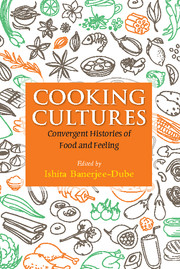Book contents
- Frontmatter
- Contents
- Acknowledgements
- Introduction: Culinary Cultures and Convergent Histories
- Part I Food, Pride, Power
- 1 Indigeneity, Alienness and Cuisine: Are Trout South African
- 2 The Hummus Wars: Local Food, Guinness Records and Palestinian-Israeli Gastropolitics
- 3 Rice, Pork and Power in the Vietnamese Village, 1774–1883
- Part II Cooking, Cuisine, Gender
- Part III Food, Identity, Personhood
- Part IV Food, Myth, Nostalgia
- Contributors
- Index
- References
3 - Rice, Pork and Power in the Vietnamese Village, 1774–1883
from Part I - Food, Pride, Power
Published online by Cambridge University Press: 05 July 2016
- Frontmatter
- Contents
- Acknowledgements
- Introduction: Culinary Cultures and Convergent Histories
- Part I Food, Pride, Power
- 1 Indigeneity, Alienness and Cuisine: Are Trout South African
- 2 The Hummus Wars: Local Food, Guinness Records and Palestinian-Israeli Gastropolitics
- 3 Rice, Pork and Power in the Vietnamese Village, 1774–1883
- Part II Cooking, Cuisine, Gender
- Part III Food, Identity, Personhood
- Part IV Food, Myth, Nostalgia
- Contributors
- Index
- References
Summary
Civil war and hunger
In the summer of 1774, much of the Vietnamese countryside faced civil war, famine, and malnutrition. Rumours of mass starvation and even cannibalism spread across the southern lands, and fueled a grass-roots revolution led by three brothers from the small village of Tây Son. These Tây Son brothers and their supporters controlled the rice fields south of the Nguyê~n lords’ capital in Hu?. In a normal summer the south would send thousands of ships full of rice to Hu?, but in 1774 none arrived. Nguyê~n forces collapsed.
The Tây Son brothers knew the value of their power to deny or provide rice to a hungry population. After solidifying control in the south, in 1786 they attacked the northern Tri?nh dynasty, longtime political rivals of the Nguyê~n Lords. To demonstrate the Tri?nh administration's incompetence, Tây Son rebels seized a major government granary and passed out rice to the people. The Tri?nh state could not have distributed that same rice to the populace, as it needed the grain to pay and feed its soldiers. The Tây Son redistribution not only won the hearts of the common people, but also depleted the supplies of the Tri?nh army (Perez, 1940, 82–83).
The Tây Son brothers continued to see food as a valuable tool and potent symbol even when there was no immediate question of starvation. In late 1788, the Chinese military swept down from the north. A few months later, Tây Son officials promised their troops a T?t feast a few days after the lunar New Year, so soldiers would not feel cheated when asked to spring a surprise T?t attack on the Chinese army. The Vietnamese troops served the Chinese an embarrassing defeat and feasted well. The Tây Son brothers knew food was key to political control; they employed gestures such as opening the rice granaries or serving a hearty banquet to mark their power and benevolence (Dutton, 2006, 107).
As for ordinary people, they ate very poorly during this period of Vietnamese civil war. A British visitor to the southern region saw people dying of hunger and heard that more than half of the population had already died in the famine. He saw no signs of the warm hospitality praised in earlier travel reports (Chapman, 1948, 23–34).
- Type
- Chapter
- Information
- Cooking CulturesConvergent Histories of Food and Feeling, pp. 58 - 76Publisher: Cambridge University PressPrint publication year: 2016
References
- 1
- Cited by



